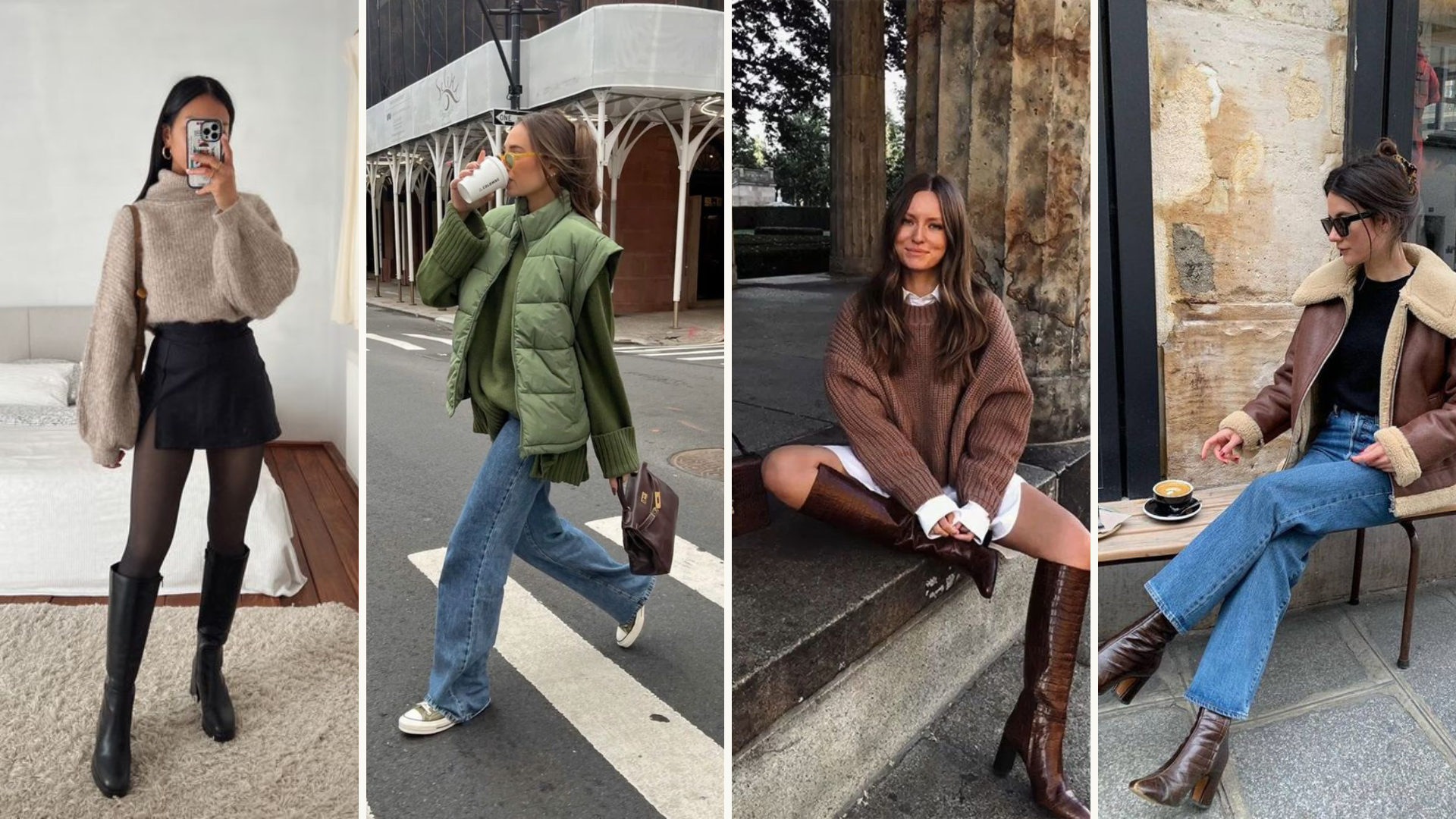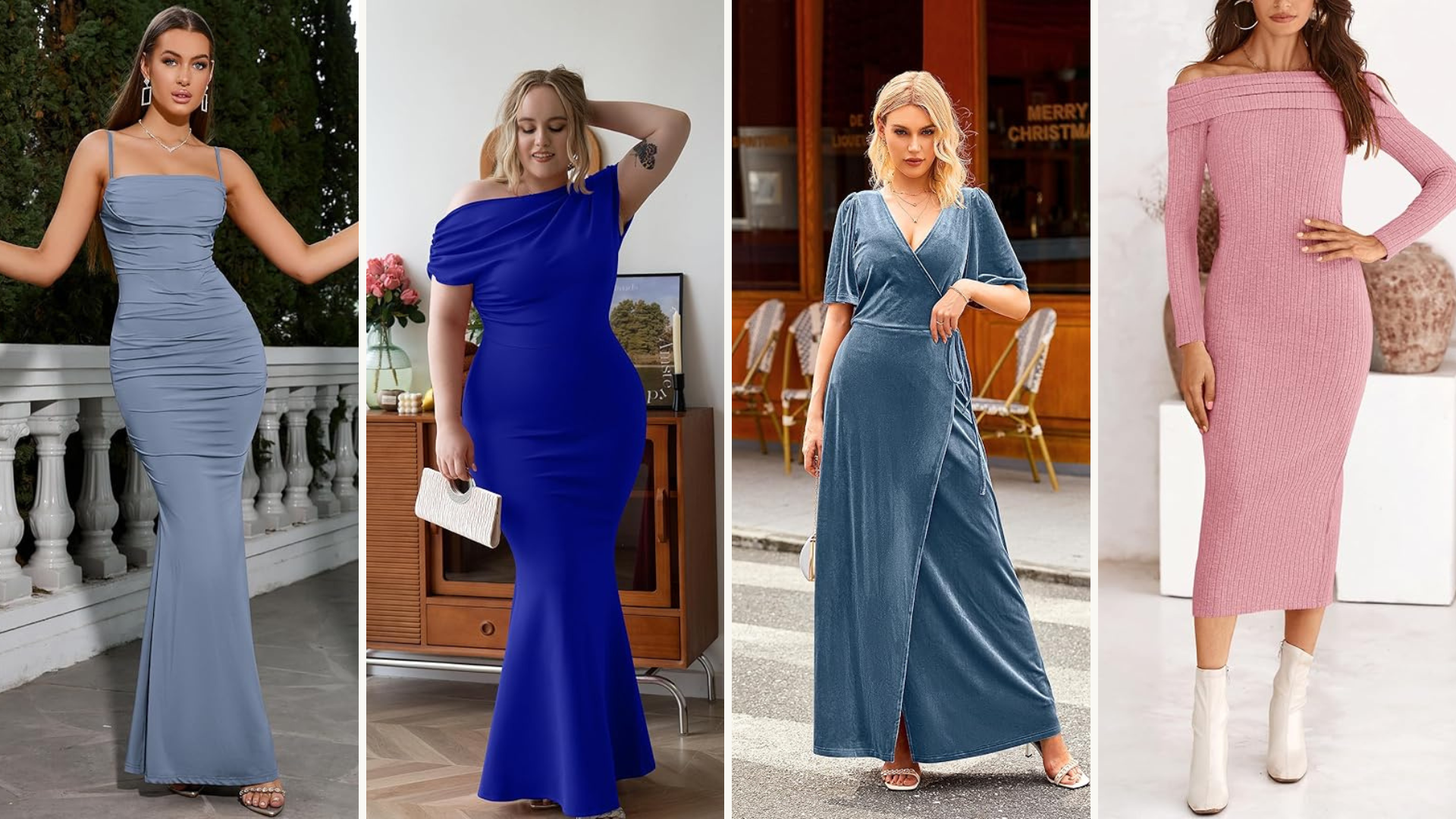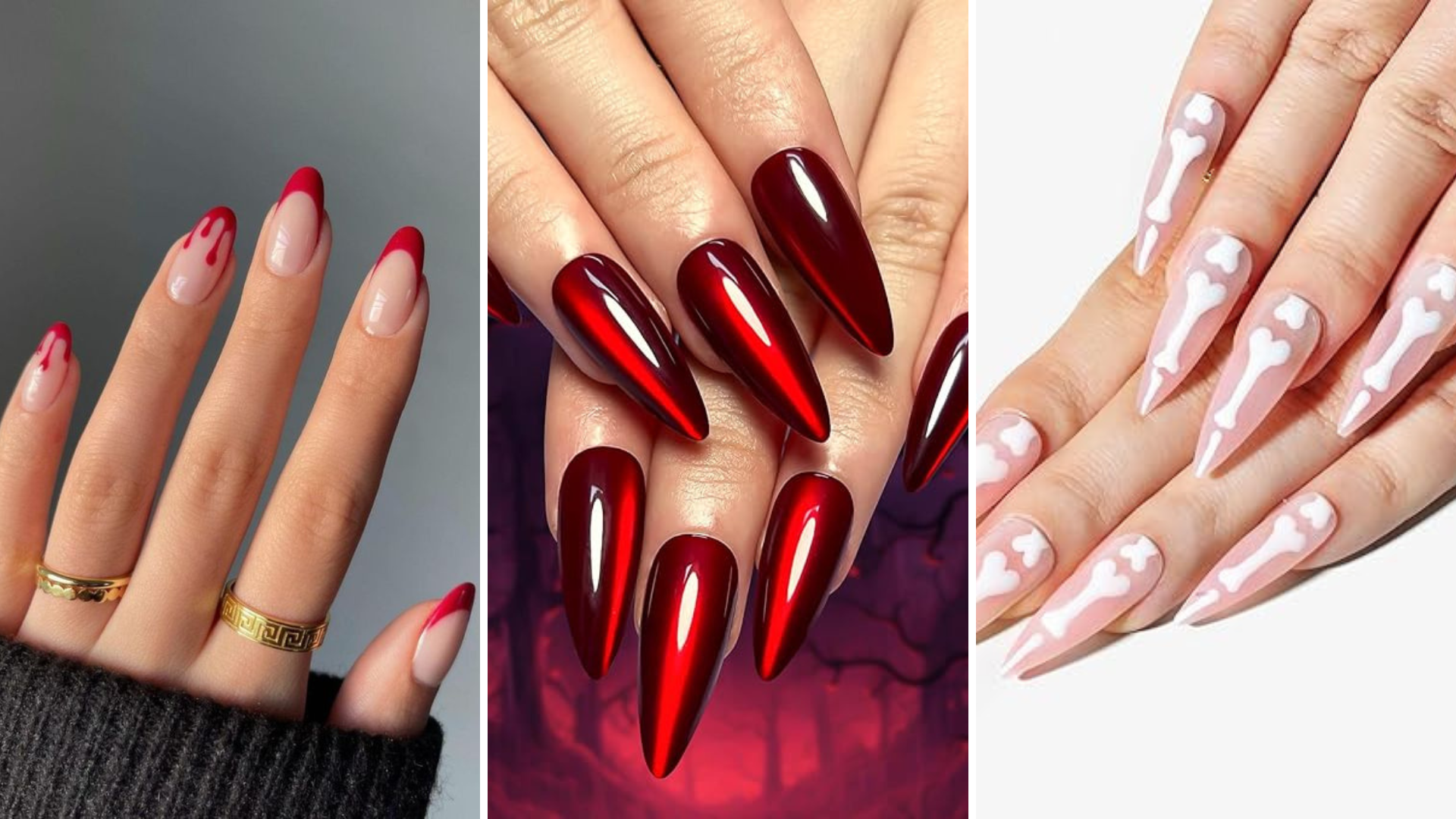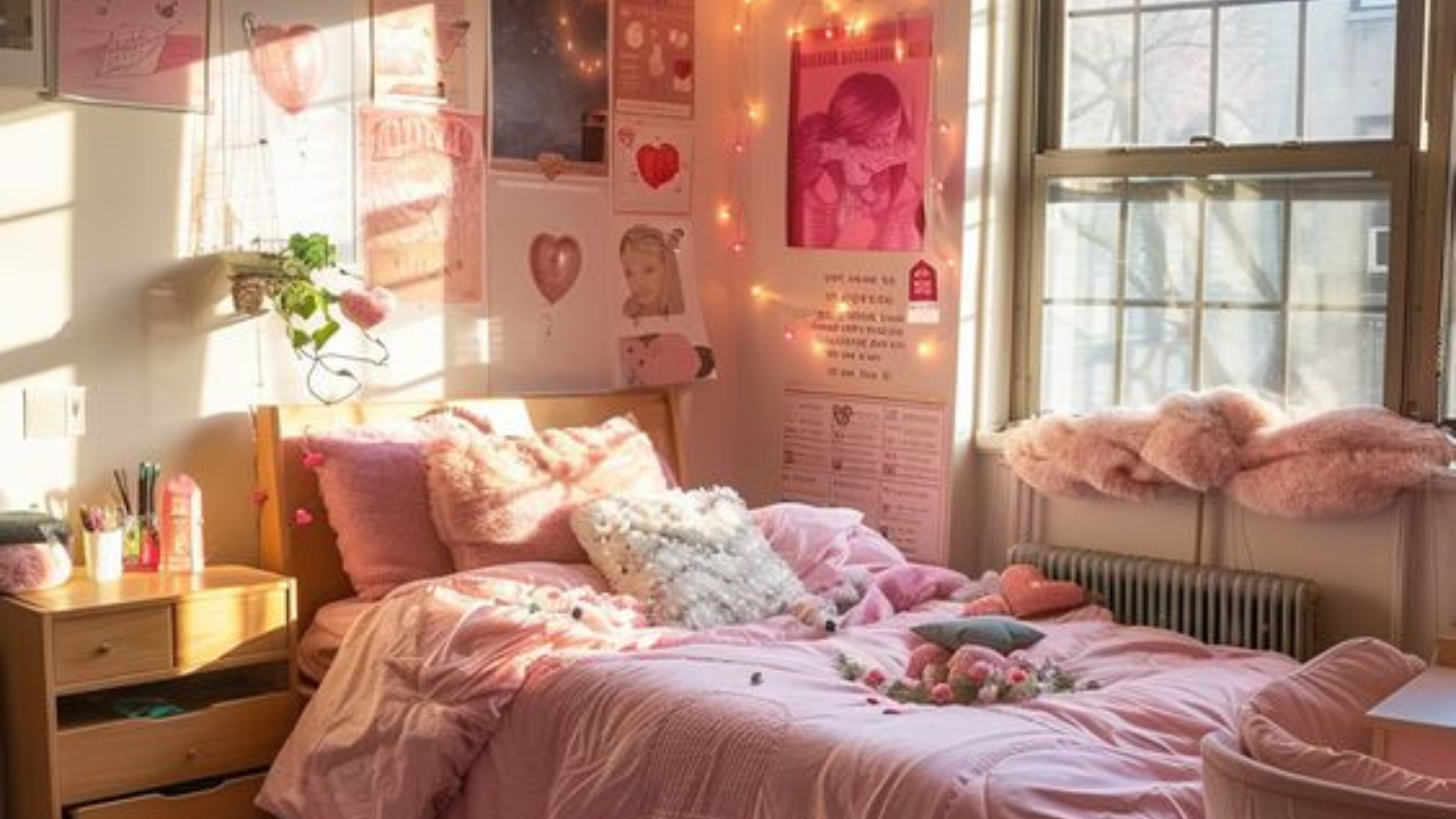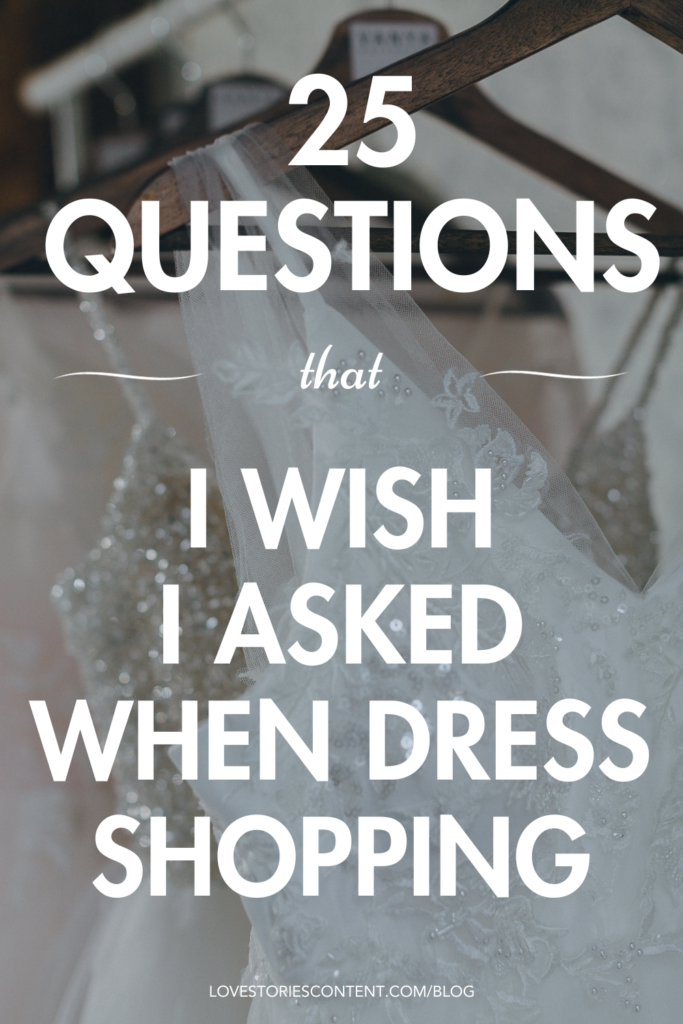
This post is about the questions that you must ask when wedding dress shopping.
You’ve booked wedding dress shopping appointment and sourced Pinterest boards for inspiration – now what? You’re likely excited to try a wedding dress on for the first time!
To fully enjoy your bridal gown fittings, we suggest having a checklist of questions to ask.
This will help you understand how the process and timelines work. It’ll also take stress off you during the appointment. That way, you can feel more relaxed to make the big decision in finding your perfect wedding dress.
We’ve sectioned the questions into three sections:
- Questions to ask before your wedding dress shopping appointment
- Questions to ask during your wedding dress shopping appointment
- Questions to ask after your wedding dress shopping appointment
Questions to ask before your wedding dress shopping appointment
Before you even set foot in a bridal shop, it’s best to ask these questions. You can reach out to the shop via their website, email or call them.
Knowing this information can help avoid any nasty surprises. It might even be the difference between them having your ideal dress in-store that day or not.

1. Does my wedding date cause constraints?
Prior to stepping into the bridal boutique, it’s crucial to consider how your chosen wedding date will impact your gown shopping experience.
After you’ve made your selection, most dresses typically require 4-6 months for delivery, along with an extra 2-3 months for any necessary alterations.
If you’re shopping close to your wedding date, your options may be limited to sample gowns or off-the-rack styles, which are dresses that have been tried on previously but are generally available for immediate purchase.
While expedited deliveries are occasionally an option at an additional cost, it’s worth noting that smaller boutiques may not accommodate last-minute orders, and designers might not always be able to meet your tight timeline.
Being aware of these constraints from the outset is advisable.
2. Are alterations part of the gown’s cost, and what is their typical expense?
Most bridal salons do not include alterations in the gown’s price, even if they have an in-house tailor. Therefore, it’s crucial to consider alteration costs before committing to a dress, especially if it’s already at the higher end of your budget.
Additionally, inquire about the pricing structure for in-house alterations—whether it’s a flat fee or based on the specific services required.
The expense for wedding dress alterations varies widely, ranging from a few hundred dollars for minor adjustments like hemming to over $1,000 for extensive changes such as reconfiguring the gown’s shape or adding intricate beading.
3.Is it possible to obtain a sample gown if it’s not available in the store?
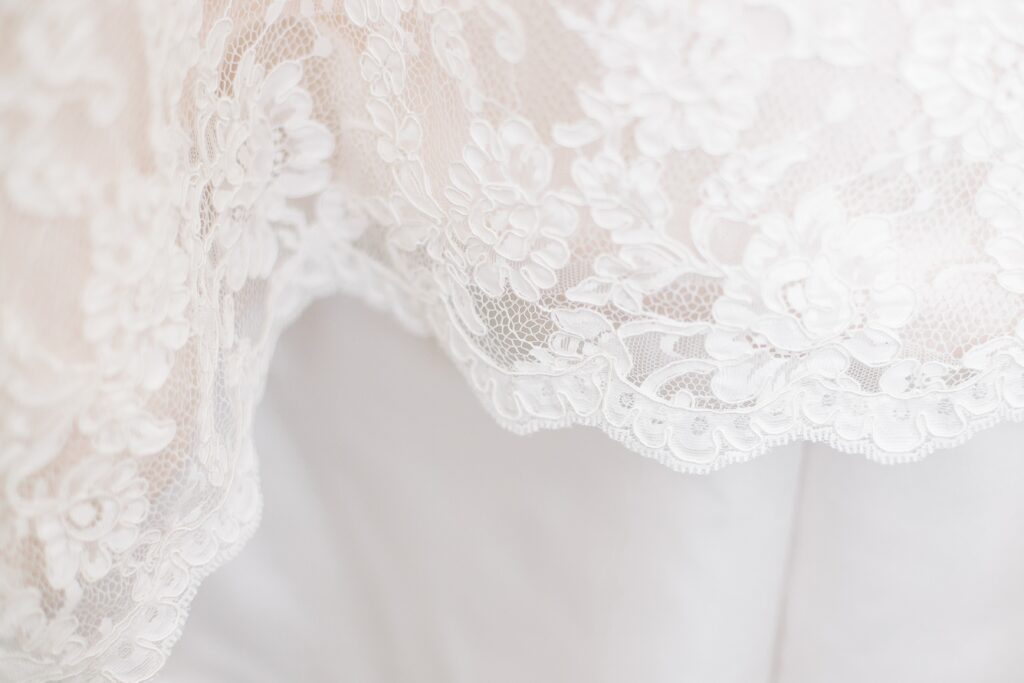
Here’s some important context: Not all bridal designers offer their entire collection at every retail location.
When a designer releases a new collection of wedding dresses, salon owners choose the styles they want to stock in their store.
They purchase sample gowns of those selected styles from the designer at a wholesale price and use these dresses for try-ons during bridal appointments.
Once you’ve found your ideal dress among the sample gowns, the salon will order a brand-new version of the dress tailored to your measurements (which explains the wait time for the dress to be ready).
So, why does this matter? If you come across a wedding dress on a designer’s website that you adore, it’s essential to locate a salon that has the dress available for you to try on in-store.
If they don’t have it, they may be able to request a sample specifically for you with sufficient notice.
4. Is there a time or dress limit?
Unlike in the movies, you likely won’t be able to try on 25 dresses and spend an afternoon at the bridal boutique.
Many wedding dress stores limit your appointment to set times like 1 hour. Given their time frame, they often recommend you to limit yourself to trying on a certain amount of dresses.
For example, with a one hour appointment, it’s often recommended to limit yourself to 5-7 dresses so that you have time to retry your favourites again towards the end of the hour.
Many shops will ask you ahead of time to list out your favourite dresses in their collection. This way they’ll have them ready for you to try so there is no wasted time.
You may be thinking that 5 dresses in one hour seems little – surely you can try on more dresses than that? Remember that each dress can take some time to get into.
You’ll also spend lots of time looking at your dress on, taking photos and videos, discussing with your family/friends and making decisions.
5. How many people can I bring to the appointment?

You might assume that you can bring as many guests as you’d like to your wedding dress shopping experience, but more often than not the shop actually places a limit on this.
You should ask how many guests you may bring to avoid any nasty surprises!
Usually, it’s for the best anyway to bring less people with you – 1-3 people is best. You don’t want too many cooks in the kitchen!
Making a decision on your wedding dress can be difficult enough – you don’t want 5 people all giving differing opinions that may distract you from your own feelings.
6. Is there a fee to try on dresses? And is there a re-try fee?
It may come as a surprise to you that some wedding dress stores charge a fee to book an appointment there.
Some stores will refund you that fee if you do end up buying a dress. Usually, there’s a higher fee for weekend appointments versus weekdays.
You should bear this in mind when budgeting for wedding dress shopping. Those fees may rack up quickly and it might force you to be more selective around which bridal shops you’ll make appointments at.
Bridal boutiques may also charge a ‘re-try fee’. This is a fee to return to the store to try on your favourite dresses again. It is usually less than a first-time appointment fee as the appointment is shorter.
7. Are there any upcoming trunk shows?
In contrast to the usual bridal dress samples, a trunk show presents the opportunity to try on an entire collection by a designer, including dresses not typically available in-store.
These events also often provide a unique chance to have a one-on-one conversation with the dress designer. This allows you to personally discuss the dress you’re interested in and any modifications you may want to make.
An added benefit: Most bridal salons typically offer a discount if you decide to purchase a gown on the spot during a designer trunk show.
8. How many fittings should I expect?
For most custom gowns, multiple rounds of alterations are necessary, so it’s crucial to inquire whether your salon provides in-house alterations and whether your dress will require additional fittings.
This becomes especially important if your body undergoes any changes between the initial try-on and purchase of the dress and when it arrives at the salon.
The initial fitting usually occurs approximately 2-3 months before your wedding day. During this fitting, the seamstress will address major alterations, such as adjusting the length, straps, bustle, or adding concealed bra cups.
Depending on the extent of changes needed, you may require one or two follow-up fittings.
Your final dress fitting should ideally happen about 2 weeks before your wedding. This ensures the most precise fit while still allowing time for professional steaming or any last-minute adjustments.
If your bridal salon doesn’t offer in-house alterations, your consultant can assist you in finding a reputable tailor experienced in working with wedding dresses.
9. What is the typical initial deposit for a wedding dress?
The average cost of a wedding dress in 2022 was $1,800.
Regardless of your budget for your dream gown, it’s customary to make an initial deposit before leaving the bridal salon. The required deposit percentage varies from one shop to another, and the final amount will depend on the price of the dress you choose.
Many brands also require a full payment up-front. To better understand their payment policies and what to expect when signing the wedding dress contract, it’s a good idea to reach out to the salon in advance.
10. What should I bring with me to the fitting appointments?
The bridal boutique will usually recommend that you bring nude coloured underwear, any bridal accessories that you might already have, and shoes that are the height of those you plan to wear on your wedding day.
We also recommend that you do your hair and makeup fairly nicely at least so that you can envision yourself on your wedding day more clearly.

Questions to ask during your wedding dress shopping appointment
It’s now time to try on wedding dresses! This can feel like such a surreal experience.
However it’s important to still ask the right questions so that you make the right decisions.
Remember that the shop consultant is an expert – they will have a good eye for knowing what will flatter you. They will also know everything about each dress and how they can be customised. So use their expertise and ask these questions during try-ons.
11. Which dress would you recommend for my body type?
If you’re brave enough to ask this question, it can be helpful to ask! Oftentimes we have in mind the style of dress we’re looking for but try to remain open-minded.
Sometimes that style that you dreamt of actually doesn’t flatter you the most. The shop consultant may know the necklines or style of dress to suit your figure best.
Also remember that the dresses will look completely different on the hanger versus on your body.
12. What can I customise about this dress?
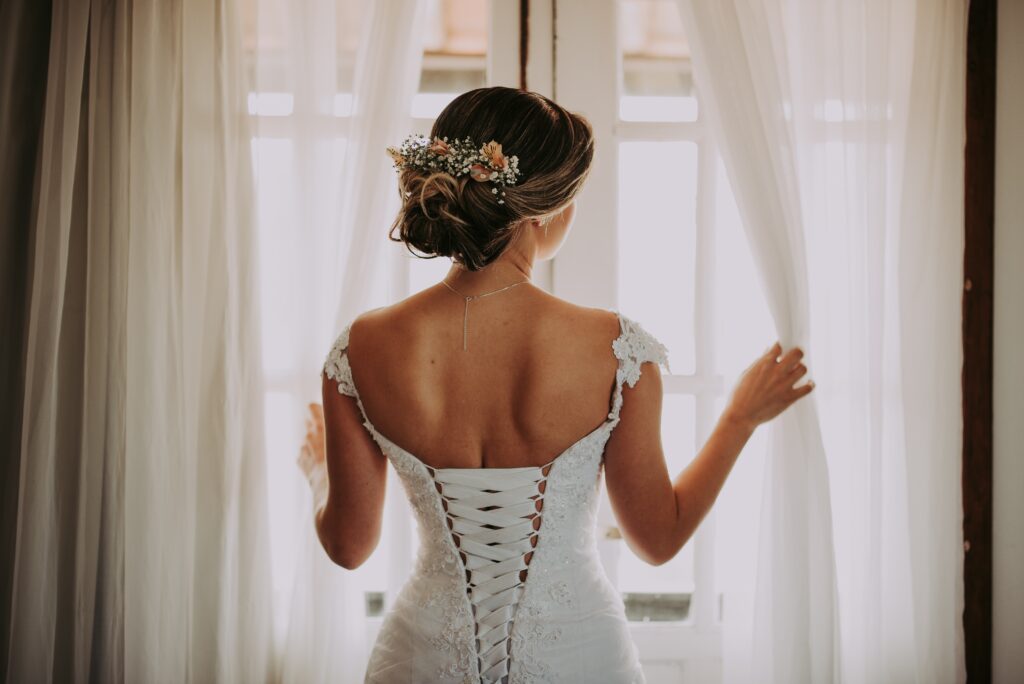
Oftentimes the colour, construction and fabric of a dress can be changed. So if you don’t like something about a dress you try on, but also love other features – let the shop consultant know this.
They will let you know if it’s possible to customise the parts you don’t like. Don’t write off a dress before discussing concerns with the shop consultant.
For example, if you want a strapless dress for your wedding ceremony but also want the option to add straps for later on, tell your consultant. It’s very likely that they can add removable straps to your dress.
13. If I buy the dress in a few weeks/months, will it still be available?
If you’ve found ‘the one’, it’s best to stop looking. You don’t want to confuse your decision with more gorgeous dresses!
However, if you do need some time to sleep on it, it’s best to ask at your appointment if the dress will still be available later on.
It’s common for designers to discontinue a line with little notice, so the bridal store might not even be able to give you a definite guarantee.
Another tip: Many stores offer a discount if you buy the dress on your first-visit – so it pays to be decisive!
14. Is it possible to buy the sample?
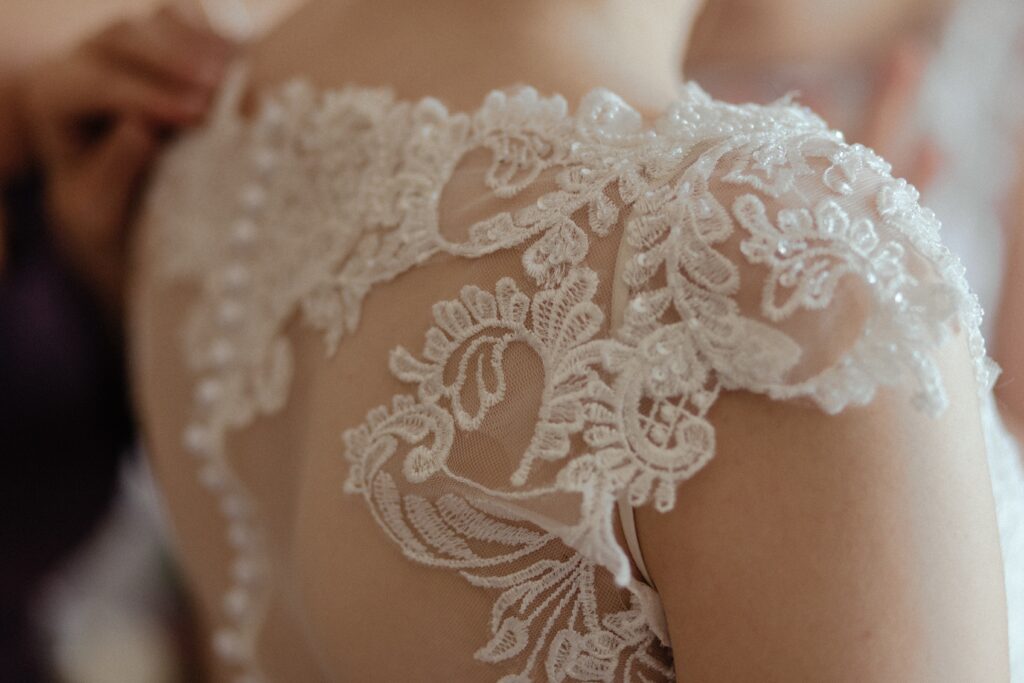
Many stores allow you to buy the sample for a heavily discounted price.
The ‘sample’ is the dress that is on the rack at the store that people have tried on. If you do choose to go this route, bear in mind that the dress will likely have marks and imperfections.
For example, there will probably be makeup stains on it. Usually, these can be fixed during alterations and a dry clean.
If the sample size is within 3 sizes of your size, it can be a great way to end up with a dress that you previously couldn’t afford.
15. Which accessories would look good with this dress?
The shop consultant has probably seen lots of different accessories tested on each dress and knows the best combinations. Ask them which accessories they’d recommend with your try-ons.
A cathedral veil or delicate gloves can really bring a dress to life, and help you visualise yourself on the day!
Even if you’re against wearing a certain accessory, like a veil, give it a go anyway – you never know until you try.
16. Which undergarments should be worn with this dress?
Once you’ve narrowed down your wedding dress choice, ask which undergarments should be worn with it. It may be that bra cups or boning can be built into the dress.
This can save you time and money trying to find the right undergarments or shape-wear. Wearing less layers will also help you avoid overheating!
17. Will this dress be practical for my wedding?
It normally is ‘fashion over function’ on your wedding day but only to an extent! If you plan to wear your wedding dress all night long, this could affect your choice.
Ask your consultant how the dress might affect your ability to sit, go to the toilet and walk.
You should also think about how the fabric and train length fit into your wedding venue. For example, if you’re getting married mid-July in Lake Como outside, it will be hot! You wouldn’t want a very heavy gown causing you to sweat.
Questions to ask after your wedding dress shopping appointment
18. What are the repercussions if I have a change of heart?
In the event that you decide to alter your dress choice after placing your order, it’s essential to understand the store’s return policies, if any exist.
Wedding gowns are typically custom orders, so most shops won’t grant a refund, but it’s advisable to verify this. There might be possibilities to recover a portion of the cost or explore alternative solutions.
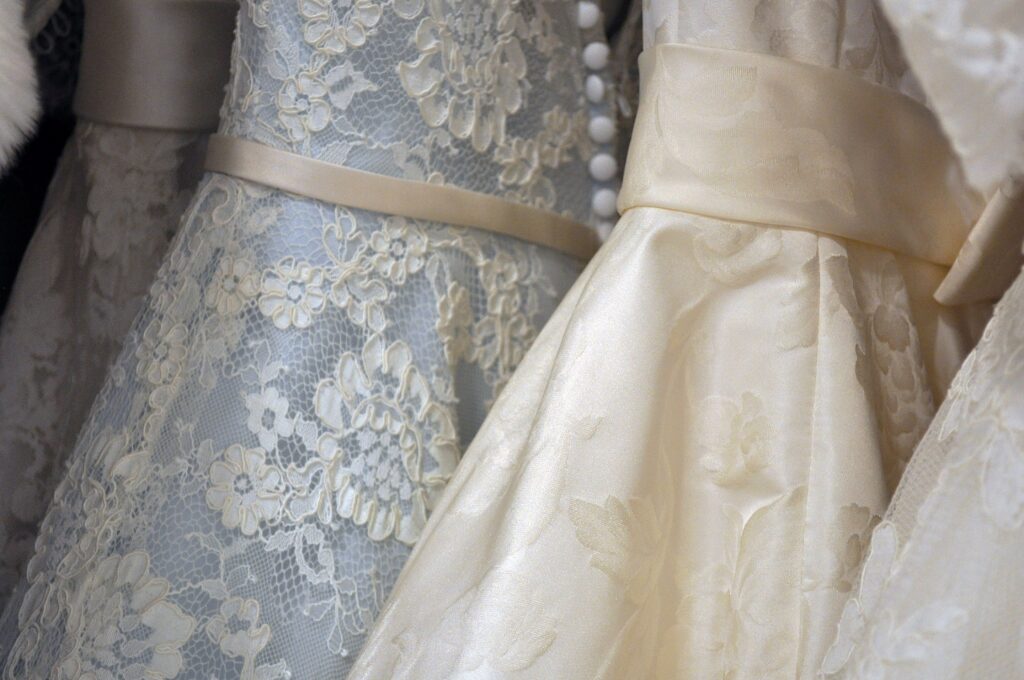
19. When is the remaining balance due for payment?
Payment expectations vary among bridal salons, so it’s crucial to clarify when the full balance for your dress is expected. Some establishments require complete payment upfront.
While others request a deposit at the conclusion of your appointment, with the remaining balance payable upon the dress’s arrival.
Ensuring you have all the specifics will prevent any misunderstandings and allow you to manage your budget effectively.
20. Will the dress undergo steaming upon pickup?
It’s an easily overlooked detail, but it’s crucial to address. You wouldn’t want to walk down the aisle in a wrinkled gown.
If your dress won’t undergo steaming when it’s ready for pickup, consider bringing a steamer on your wedding day or inquire whether your venue can provide one (they might have a steamer available in the dressing suites).
If a separate seamstress is handling alterations apart from your bridal salon, it’s also prudent to ask whether your dress will be steamed or pressed in advance.
21. How should put my gown on?
Although it may seem like a trivial question, it’s crucial to inquire about the proper method for putting on your dress, especially if it features interior buttons, a lace-up back, or a complex skirt that requires bustling.
Understanding how to wear it correctly can save you time and avoid frustration when the big day arrives.
It’s advisable to have someone who will be getting ready with you on your wedding day, such as a family member or bridesmaid, attend your fittings to take notes on how to assist you with dressing.
22. What’s the recommended approach for storing and transporting my gown?
When you pick up your dress from the salon or seamstress, it will likely be pressed and packed. Once it’s in your possession, you should be aware of the proper storage and transportation methods to ensure it reaches your wedding venue in pristine condition.
If you plan to store it outside of the salon, use a protective, opaque garment bag. This not only prevents prying eyes but also shields it from sunlight and potential discolouration.
If you’re having a destination wedding, consider traveling with your dress in a garment bag (preferably as a carry-on to keep it within your sight) and arrange for steaming upon arrival.
23. How can I clean my wedding dress?
After your wedding, you might want to wash your wedding dress so that you can store, rent or sell it. It’s important to ask how the dress should be cleaned, if it’s even possible.
24. How much will the alterations cost?
Now that you’ve chosen your dress and the shop consultant knows what alterations and customisations are likely needed, they can give you quite an accurate estimation.
If the alteration service is done in-house, they can book you in. If alterations are outsourced, they will recommend a high-quality seamstress that they have likely worked with for years. Reach out to that contact as soon as possible to book in your alteration dates.
25. How long will the alterations take?
Alterations typically take around 2 months at the most to complete. We recommend booking your first alteration for 8 weeks before you wedding day, and the last one about 2 weeks before your wedding. You want your final fitting to be as close to your wedding date as possible to get the most precise fit.
Now that you’ve got your checklist, go enjoy your wedding dress shopping experience! If you’re getting married soon in Europe and want a wedding content creator to capture the BTS of your special day, reach out to us at Love Stories Content.
This post was about the 25 questions to ask when wedding dress shopping.
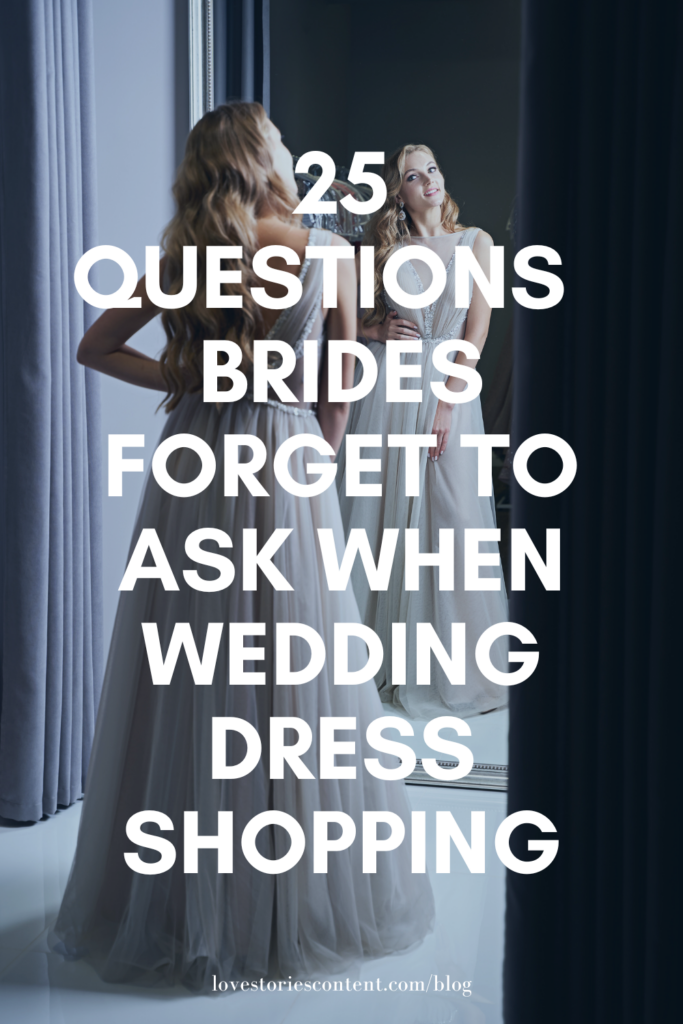
View more posts
You'll Also Love
© 2023 love stories content All Rights Reserved

